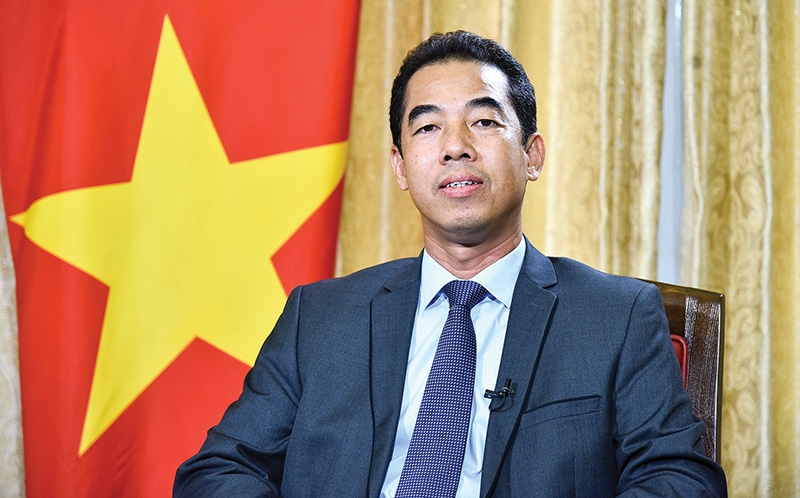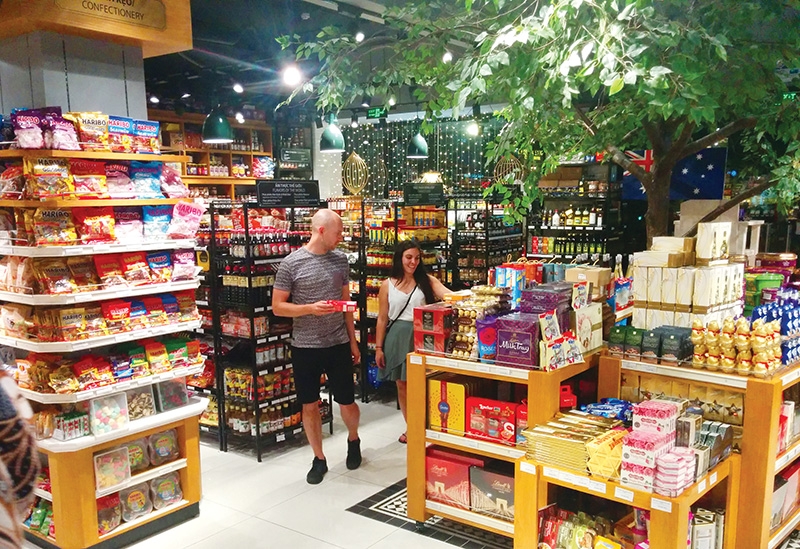Door swings open for further EU-Vietnam development
 |
| Deputy Minister of Foreign Affairs To Anh Dung |
Looking back to the 30 years of diplomatic ties between Vietnam and the EU, we can see spectacular and rapid strides in the relationship. From cooperation in some sectors, both sides’ ties have developed to the Partnership and Cooperation Agreement (PCA) when a new framework cooperation agreement was signed in 2012, replacing the EU-Vietnam Framework Cooperation Agreement inked in 1995.
The strong development of the relationship illustrates the reliable partnership and friendship and co-sharing of a long-term vision of both sides in enhancing their bilateral ties and contributing to peace, cooperation, and development in the two regions and the wider world.
On the occasion of this event, Vietnamese leaders of the state, government, National Assembly, and the Ministry of Foreign Affairs, and those of the Commission, Council, and Parliament of the EU have exchanged letters of congratulation, reaffirming the importance of both sides’ relationship.
In 2020, exchanges between Vietnam and the EU were vivid, despite massive difficulties caused by COVID-19. Prime Minister Nguyen Xuan Phuc held a telephone talk with President of the European Commission Ursula Von de Leyen in July, exchanging bilateral cooperation including the effective implementation of the EU-Vietnam Free Trade Agreement (EVFTA). Minister of Industry and Trade Tran Tuan Anh and Permanent Deputy Minister of Foreign Affairs Bui Thanh Son also had telephone talks with the EU trade commissioner in May and June 2020, respectively.
It can be said that both sides’ existing ties result from dynamic changes in bilateral cooperation from traditional sectors like politics-diplomacy, trade-investment, and development cooperation to other potential sectors like science-technology, security-defence, agro-forestry-fishery, and innovation, as well as in many important multilateral frameworks, contributing to further improving the Vietnam-EU cooperation.
For Vietnam, the EU is one of the leading strategic partners with an important role in the international arena, and in issues on security, peace, economy, and development.
With its increasingly-growing strength and status after 35 years of national renovation, the country has become a strong partner of the EU within ASEAN and in Asia Pacific, with close cooperation in all sectors, and Vietnam is one of the partners that the EU has the most comprehensive relationship with in the region.
One of the attestations for efforts in fostering both sides’ particular and vivid relationship, demonstrating a political imprint and will, is both sides frequently exchanging visits. Specifically, Party General Secretary, State President Nguyen Phu Trong paid a high-level visit to the EU in 2013 and Prime Minister Nguyen Xuan Phuc in 2018, and National Assembly Chairwoman Nguyen Thi Kim Ngan in 2019. Many leaders of the Commission, Council, and Parliament of the EU also visited Vietnam.
In 2020, while having to cope with the dual crisis in health and economy, both sides still maintained the implementation of commitments and conducted exchanges and cooperation both physically and online. They continued their close combination in many sectors in order to promote important achievements from intensive cooperation in the past, while actively implementing mutual support in anti-pandemic equipment, with the EU assisting Vietnam’s central provinces suffering from natural disasters in October.
 |
| Vietnam is expected to welcome even more EU-originated products, and vice versa, photo Le Toan |
Strength of the EVFTA
The important event marking the latest historic milestone in the bilateral ties was the signing, approval, and entry into force of the EVFTA on August 1, 2020, which has a wide range of commitments, creating many new breakthroughs and prospects for the relationship. This is also the shared efforts by the two sides in boosting the overall trend in international economic connectivity and sustainable development.
Only five months after the agreement taking effect, both sides’ two-way trade flourished, with many Vietnamese exports strongly increasing in the EU market such as aquatic products, rice, garments and textiles, and footwear. The EU is now the fifth-largest trade partner, the third-largest export market, and a big foreign investor of Vietnam. It is also a leading non-refundable aid donor for the country.
The EVFTA ushers in enormous opportunities for Vietnamese enterprises to enter the EU market home to a population of nearly 450 million people and a GDP scale of about $18 trillion. This will help Vietnam diversify its export markets and carve a firm niche in the EU market, while taking advantage of new opportunities in addition to other advantages resulting from the country’s good control of COVID-19 and maintenance of positive economic growth. This will also enable Vietnam to further join the global value chains.
The EVFTA has made an important contribution to both sides boosting economic recovery and regaining growth momentum given the decline in the global economy caused by COVID-19.
Besides the economic pillar and trade being a focus in the Vietnam-EU cooperation, many other cooperation sectors have also witnessed big strides. The signing of the Framework Participation Agreement for Vietnam’s Participation in Crisis Management Activities of the EU, and Voluntary Partnership Agreement on Forest Law Enforcement, Governance and Trade have been significant achievements, opening up prospects for strengthening more multi-faceted and comprehensive relations between Vietnam and the EU.
Both sides successfully organised meetings of the joint committee on implementing the PCA for the first time in May 2019, and online for the second time in December 2020. This has helped boost the effective implementation of commitments, contributing to the realisation and further sharpening of the Vietnam-EU comprehensive partnership.
Multilateral cooperation
Multilateral cooperation has been attached importance to by the two sides, in which the bonds between ASEAN and the EU have been increasingly strengthened. The EU has major benefits in the Asia-Pacific region, as 40 per cent of the EU’s exported and imported goods are with Asia.
With the adoption of the EU Global Strategy in 2016, and the Asia-Europe Connectivity Strategy in 2018, the EU and its member states have demonstrated a strategic vision in the region. Vietnam and ASEAN are pursuing trustful cooperation, and want the EU to play a positive and constructive role in the region for peace, prosperity, and boosting multilateralism, trade liberalisation, and respect for the law.
The 23rd ASEAN-EU Ministerial Meeting and the seventh ASEAN Defence Ministers’ Meeting Plus organised in December 2020 reaffirmed the consensus of all the parties via the EU-ASEAN joint ministerial statement on connectivity and forging the ASEAN-EU Strategic Partnership, to which Vietnam had made important contributions as ASEAN chair 2020.
Last year ended with challenging tasks proudly weathered by Vietnam that has shone and demonstrated its big role and status in successfully undertaking the role as ASEAN chair, non-permanent member of the United Nations Security Council for the term 2020-2021, and chair of the 41st General Assembly of the ASEAN Inter-Parliamentary Assembly.
The EU, which is a particular economic and political institution with a deep connectivity level and leading importance in the world and having a big voice in the UN and in the international arena, has been beefing up its close and comprehensive cooperation with ASEAN and its member states including Vietnam. The EU is increasingly demonstrating its clear and strong stance and viewpoints in ensuring maritime security, the law order, and maintaining peace and stability in the East Sea.
Over the past 30 years of cooperation and development, the Vietnam-EU relationship has made big strides based on clear-sighted and strategic visions in order to enhance the stature of the partnership. From the first brick used for establishing the foundation of the bilateral ties, the relationship has so far strongly developed with sustainable, firm, and intensive foundations, promising a spillover momentum in 2021 and many following years.
What the stars mean:
★ Poor ★ ★ Promising ★★★ Good ★★★★ Very good ★★★★★ Exceptional
Related Contents
Latest News
More News
- Government moves to establish International Financial Centre (December 21, 2025 | 21:00)
- Vietnam's IFC to target global investment flows (December 21, 2025 | 18:00)
- Two national hospitals expand capacity with new facilities (December 20, 2025 | 09:00)
- Ha Tinh breaks ground on major Vingroup industrial and energy projects (December 19, 2025 | 18:24)
- EVN launches major power infrastructure projects nationwide (December 19, 2025 | 18:17)
- VAL inaugurates second production line to meet domestic animal feed demand (December 19, 2025 | 16:37)
- Sun Group pioneers urban tram system in Phu Quoc (December 19, 2025 | 15:00)
- Seven major projects launched to drive Hanoi’s next growth phase (December 19, 2025 | 14:00)
- Securing capital and efficiency for Vietnam’s 2026-2030 growth ambitions (December 17, 2025 | 10:00)
- Vietnam bucking trend in the global M&A landscape (December 16, 2025 | 14:20)

 Tag:
Tag:




















 Mobile Version
Mobile Version